Plagiarism in Academic Writing: Definition, Detection, and Prevention
VerifiedAdded on 2023/06/08
|6
|1365
|247
Essay
AI Summary
This essay provides a comprehensive overview of plagiarism, defining it as the unacknowledged use of another's work and emphasizing its seriousness as academic misconduct. It explores various forms of plagiarism, including self-plagiarism and mosaic plagiarism, detailing how each manifests in academic writing. The essay discusses methods for detecting plagiarism, highlighting the role of technology and the importance of careful review by knowledgeable individuals. Furthermore, it outlines strategies for avoiding plagiarism through ethical writing practices and proper citation, and addresses the appropriate actions to take when plagiarism is suspected or discovered, emphasizing the responsibility of editors and institutions. The essay concludes by advocating for increased awareness and adherence to ethical standards to maintain integrity in academic and scholarly work; students can find more resources and solved assignments on Desklib.
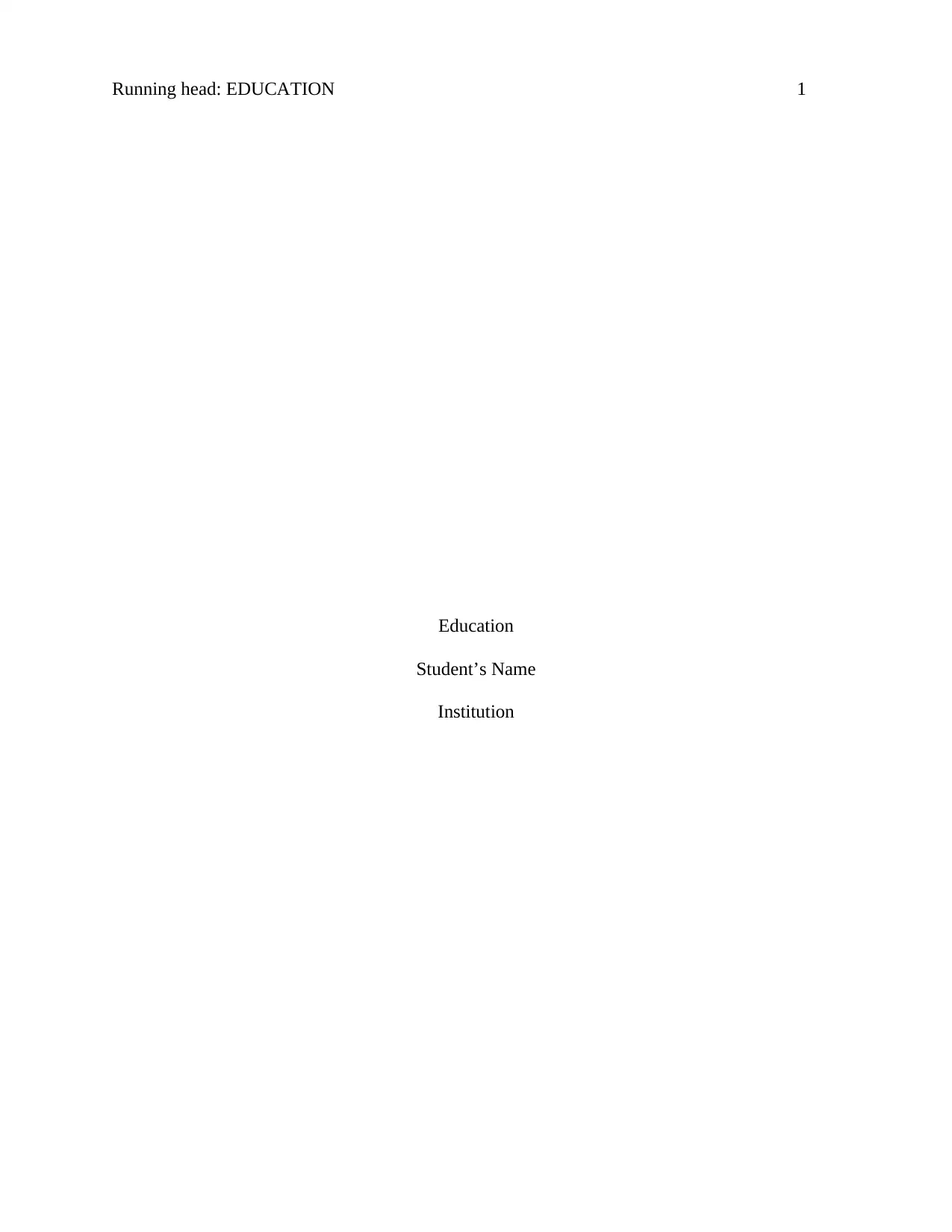
Running head: EDUCATION 1
Education
Student’s Name
Institution
Education
Student’s Name
Institution
Paraphrase This Document
Need a fresh take? Get an instant paraphrase of this document with our AI Paraphraser
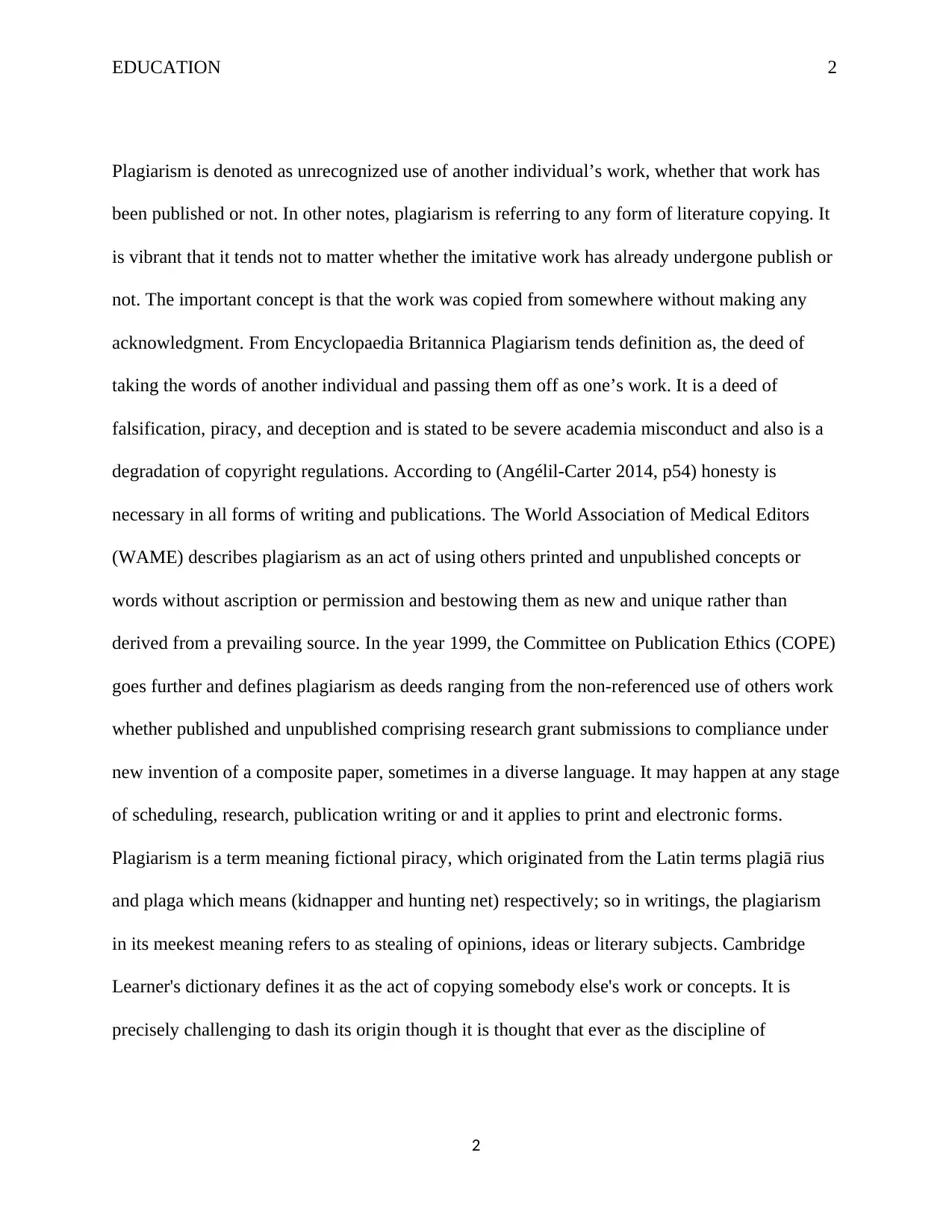
EDUCATION 2
Plagiarism is denoted as unrecognized use of another individual’s work, whether that work has
been published or not. In other notes, plagiarism is referring to any form of literature copying. It
is vibrant that it tends not to matter whether the imitative work has already undergone publish or
not. The important concept is that the work was copied from somewhere without making any
acknowledgment. From Encyclopaedia Britannica Plagiarism tends definition as, the deed of
taking the words of another individual and passing them off as one’s work. It is a deed of
falsification, piracy, and deception and is stated to be severe academia misconduct and also is a
degradation of copyright regulations. According to (Angélil-Carter 2014, p54) honesty is
necessary in all forms of writing and publications. The World Association of Medical Editors
(WAME) describes plagiarism as an act of using others printed and unpublished concepts or
words without ascription or permission and bestowing them as new and unique rather than
derived from a prevailing source. In the year 1999, the Committee on Publication Ethics (COPE)
goes further and defines plagiarism as deeds ranging from the non-referenced use of others work
whether published and unpublished comprising research grant submissions to compliance under
new invention of a composite paper, sometimes in a diverse language. It may happen at any stage
of scheduling, research, publication writing or and it applies to print and electronic forms.
Plagiarism is a term meaning fictional piracy, which originated from the Latin terms plagiā rius
and plaga which means (kidnapper and hunting net) respectively; so in writings, the plagiarism
in its meekest meaning refers to as stealing of opinions, ideas or literary subjects. Cambridge
Learner's dictionary defines it as the act of copying somebody else's work or concepts. It is
precisely challenging to dash its origin though it is thought that ever as the discipline of
2
Plagiarism is denoted as unrecognized use of another individual’s work, whether that work has
been published or not. In other notes, plagiarism is referring to any form of literature copying. It
is vibrant that it tends not to matter whether the imitative work has already undergone publish or
not. The important concept is that the work was copied from somewhere without making any
acknowledgment. From Encyclopaedia Britannica Plagiarism tends definition as, the deed of
taking the words of another individual and passing them off as one’s work. It is a deed of
falsification, piracy, and deception and is stated to be severe academia misconduct and also is a
degradation of copyright regulations. According to (Angélil-Carter 2014, p54) honesty is
necessary in all forms of writing and publications. The World Association of Medical Editors
(WAME) describes plagiarism as an act of using others printed and unpublished concepts or
words without ascription or permission and bestowing them as new and unique rather than
derived from a prevailing source. In the year 1999, the Committee on Publication Ethics (COPE)
goes further and defines plagiarism as deeds ranging from the non-referenced use of others work
whether published and unpublished comprising research grant submissions to compliance under
new invention of a composite paper, sometimes in a diverse language. It may happen at any stage
of scheduling, research, publication writing or and it applies to print and electronic forms.
Plagiarism is a term meaning fictional piracy, which originated from the Latin terms plagiā rius
and plaga which means (kidnapper and hunting net) respectively; so in writings, the plagiarism
in its meekest meaning refers to as stealing of opinions, ideas or literary subjects. Cambridge
Learner's dictionary defines it as the act of copying somebody else's work or concepts. It is
precisely challenging to dash its origin though it is thought that ever as the discipline of
2
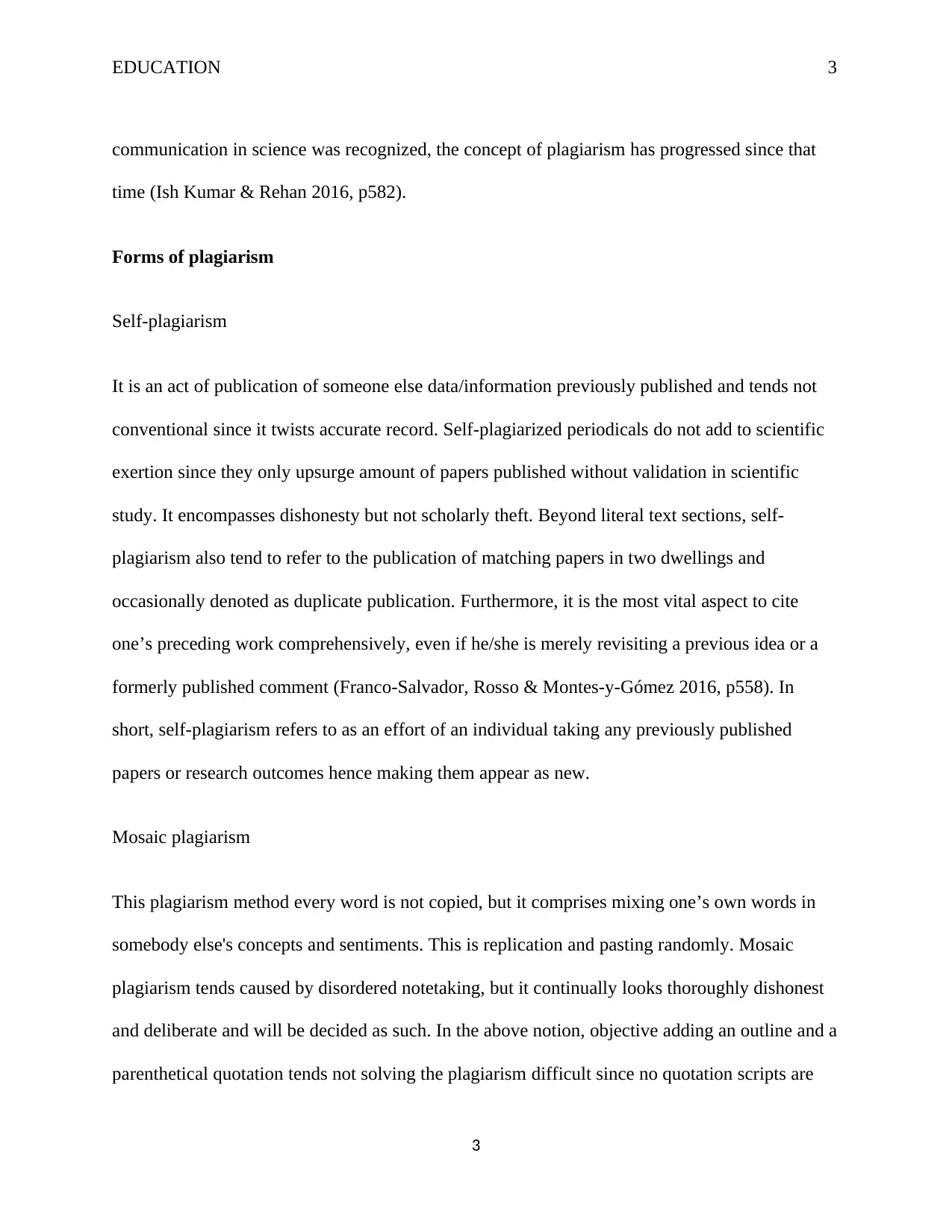
EDUCATION 3
communication in science was recognized, the concept of plagiarism has progressed since that
time (Ish Kumar & Rehan 2016, p582).
Forms of plagiarism
Self-plagiarism
It is an act of publication of someone else data/information previously published and tends not
conventional since it twists accurate record. Self-plagiarized periodicals do not add to scientific
exertion since they only upsurge amount of papers published without validation in scientific
study. It encompasses dishonesty but not scholarly theft. Beyond literal text sections, self-
plagiarism also tend to refer to the publication of matching papers in two dwellings and
occasionally denoted as duplicate publication. Furthermore, it is the most vital aspect to cite
one’s preceding work comprehensively, even if he/she is merely revisiting a previous idea or a
formerly published comment (Franco-Salvador, Rosso & Montes-y-Gómez 2016, p558). In
short, self-plagiarism refers to as an effort of an individual taking any previously published
papers or research outcomes hence making them appear as new.
Mosaic plagiarism
This plagiarism method every word is not copied, but it comprises mixing one’s own words in
somebody else's concepts and sentiments. This is replication and pasting randomly. Mosaic
plagiarism tends caused by disordered notetaking, but it continually looks thoroughly dishonest
and deliberate and will be decided as such. In the above notion, objective adding an outline and a
parenthetical quotation tends not solving the plagiarism difficult since no quotation scripts are
3
communication in science was recognized, the concept of plagiarism has progressed since that
time (Ish Kumar & Rehan 2016, p582).
Forms of plagiarism
Self-plagiarism
It is an act of publication of someone else data/information previously published and tends not
conventional since it twists accurate record. Self-plagiarized periodicals do not add to scientific
exertion since they only upsurge amount of papers published without validation in scientific
study. It encompasses dishonesty but not scholarly theft. Beyond literal text sections, self-
plagiarism also tend to refer to the publication of matching papers in two dwellings and
occasionally denoted as duplicate publication. Furthermore, it is the most vital aspect to cite
one’s preceding work comprehensively, even if he/she is merely revisiting a previous idea or a
formerly published comment (Franco-Salvador, Rosso & Montes-y-Gómez 2016, p558). In
short, self-plagiarism refers to as an effort of an individual taking any previously published
papers or research outcomes hence making them appear as new.
Mosaic plagiarism
This plagiarism method every word is not copied, but it comprises mixing one’s own words in
somebody else's concepts and sentiments. This is replication and pasting randomly. Mosaic
plagiarism tends caused by disordered notetaking, but it continually looks thoroughly dishonest
and deliberate and will be decided as such. In the above notion, objective adding an outline and a
parenthetical quotation tends not solving the plagiarism difficult since no quotation scripts are
3
⊘ This is a preview!⊘
Do you want full access?
Subscribe today to unlock all pages.

Trusted by 1+ million students worldwide
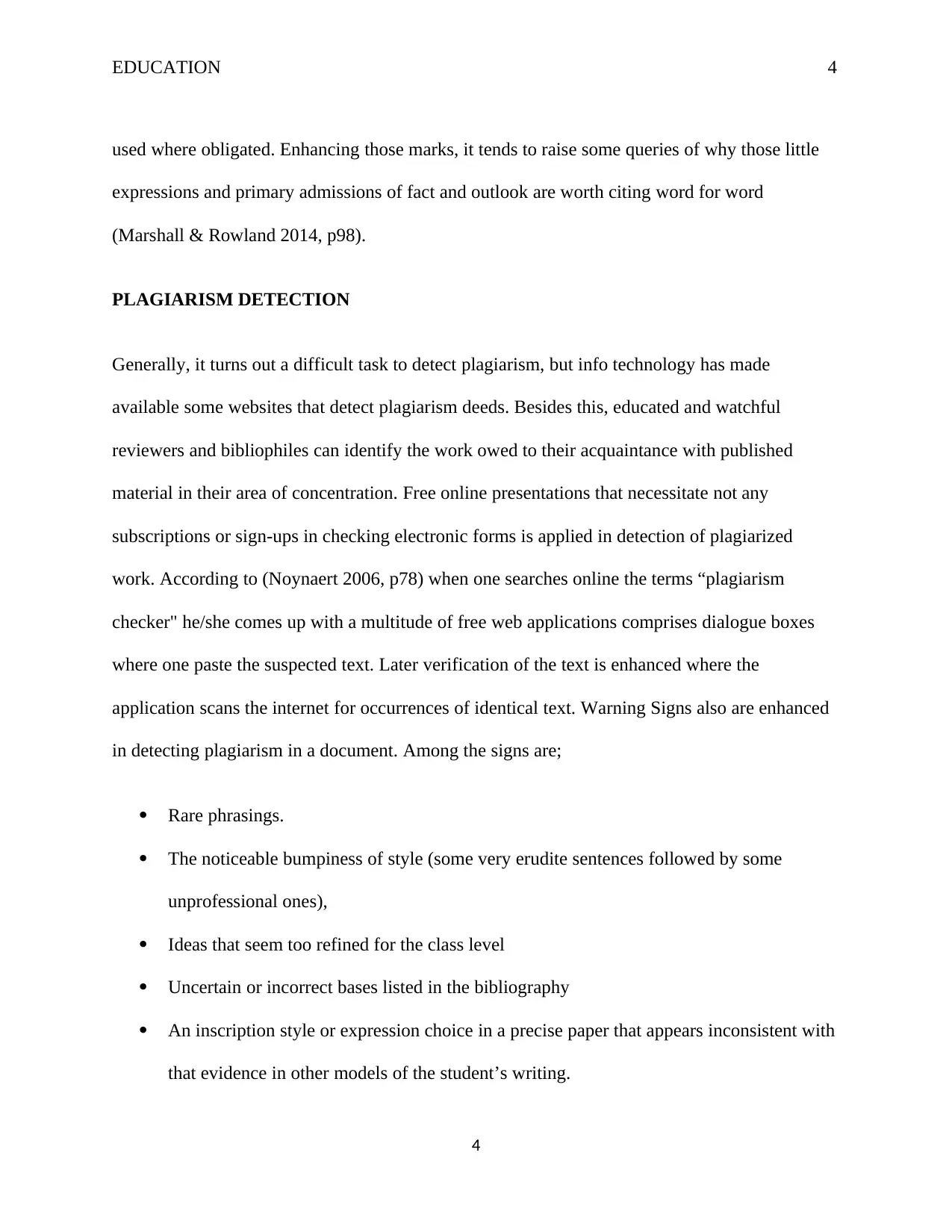
EDUCATION 4
used where obligated. Enhancing those marks, it tends to raise some queries of why those little
expressions and primary admissions of fact and outlook are worth citing word for word
(Marshall & Rowland 2014, p98).
PLAGIARISM DETECTION
Generally, it turns out a difficult task to detect plagiarism, but info technology has made
available some websites that detect plagiarism deeds. Besides this, educated and watchful
reviewers and bibliophiles can identify the work owed to their acquaintance with published
material in their area of concentration. Free online presentations that necessitate not any
subscriptions or sign-ups in checking electronic forms is applied in detection of plagiarized
work. According to (Noynaert 2006, p78) when one searches online the terms “plagiarism
checker" he/she comes up with a multitude of free web applications comprises dialogue boxes
where one paste the suspected text. Later verification of the text is enhanced where the
application scans the internet for occurrences of identical text. Warning Signs also are enhanced
in detecting plagiarism in a document. Among the signs are;
Rare phrasings.
The noticeable bumpiness of style (some very erudite sentences followed by some
unprofessional ones),
Ideas that seem too refined for the class level
Uncertain or incorrect bases listed in the bibliography
An inscription style or expression choice in a precise paper that appears inconsistent with
that evidence in other models of the student’s writing.
4
used where obligated. Enhancing those marks, it tends to raise some queries of why those little
expressions and primary admissions of fact and outlook are worth citing word for word
(Marshall & Rowland 2014, p98).
PLAGIARISM DETECTION
Generally, it turns out a difficult task to detect plagiarism, but info technology has made
available some websites that detect plagiarism deeds. Besides this, educated and watchful
reviewers and bibliophiles can identify the work owed to their acquaintance with published
material in their area of concentration. Free online presentations that necessitate not any
subscriptions or sign-ups in checking electronic forms is applied in detection of plagiarized
work. According to (Noynaert 2006, p78) when one searches online the terms “plagiarism
checker" he/she comes up with a multitude of free web applications comprises dialogue boxes
where one paste the suspected text. Later verification of the text is enhanced where the
application scans the internet for occurrences of identical text. Warning Signs also are enhanced
in detecting plagiarism in a document. Among the signs are;
Rare phrasings.
The noticeable bumpiness of style (some very erudite sentences followed by some
unprofessional ones),
Ideas that seem too refined for the class level
Uncertain or incorrect bases listed in the bibliography
An inscription style or expression choice in a precise paper that appears inconsistent with
that evidence in other models of the student’s writing.
4
Paraphrase This Document
Need a fresh take? Get an instant paraphrase of this document with our AI Paraphraser
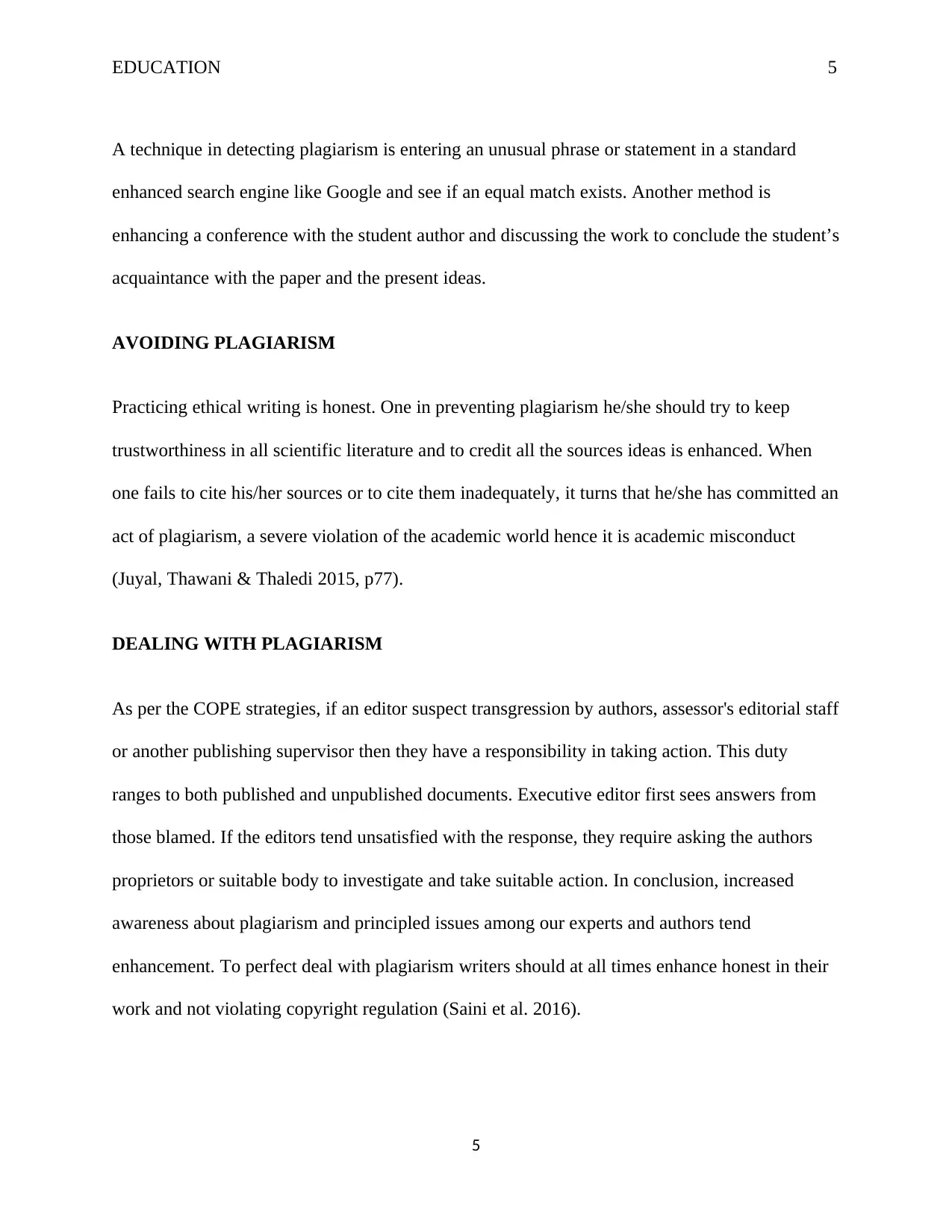
EDUCATION 5
A technique in detecting plagiarism is entering an unusual phrase or statement in a standard
enhanced search engine like Google and see if an equal match exists. Another method is
enhancing a conference with the student author and discussing the work to conclude the student’s
acquaintance with the paper and the present ideas.
AVOIDING PLAGIARISM
Practicing ethical writing is honest. One in preventing plagiarism he/she should try to keep
trustworthiness in all scientific literature and to credit all the sources ideas is enhanced. When
one fails to cite his/her sources or to cite them inadequately, it turns that he/she has committed an
act of plagiarism, a severe violation of the academic world hence it is academic misconduct
(Juyal, Thawani & Thaledi 2015, p77).
DEALING WITH PLAGIARISM
As per the COPE strategies, if an editor suspect transgression by authors, assessor's editorial staff
or another publishing supervisor then they have a responsibility in taking action. This duty
ranges to both published and unpublished documents. Executive editor first sees answers from
those blamed. If the editors tend unsatisfied with the response, they require asking the authors
proprietors or suitable body to investigate and take suitable action. In conclusion, increased
awareness about plagiarism and principled issues among our experts and authors tend
enhancement. To perfect deal with plagiarism writers should at all times enhance honest in their
work and not violating copyright regulation (Saini et al. 2016).
5
A technique in detecting plagiarism is entering an unusual phrase or statement in a standard
enhanced search engine like Google and see if an equal match exists. Another method is
enhancing a conference with the student author and discussing the work to conclude the student’s
acquaintance with the paper and the present ideas.
AVOIDING PLAGIARISM
Practicing ethical writing is honest. One in preventing plagiarism he/she should try to keep
trustworthiness in all scientific literature and to credit all the sources ideas is enhanced. When
one fails to cite his/her sources or to cite them inadequately, it turns that he/she has committed an
act of plagiarism, a severe violation of the academic world hence it is academic misconduct
(Juyal, Thawani & Thaledi 2015, p77).
DEALING WITH PLAGIARISM
As per the COPE strategies, if an editor suspect transgression by authors, assessor's editorial staff
or another publishing supervisor then they have a responsibility in taking action. This duty
ranges to both published and unpublished documents. Executive editor first sees answers from
those blamed. If the editors tend unsatisfied with the response, they require asking the authors
proprietors or suitable body to investigate and take suitable action. In conclusion, increased
awareness about plagiarism and principled issues among our experts and authors tend
enhancement. To perfect deal with plagiarism writers should at all times enhance honest in their
work and not violating copyright regulation (Saini et al. 2016).
5
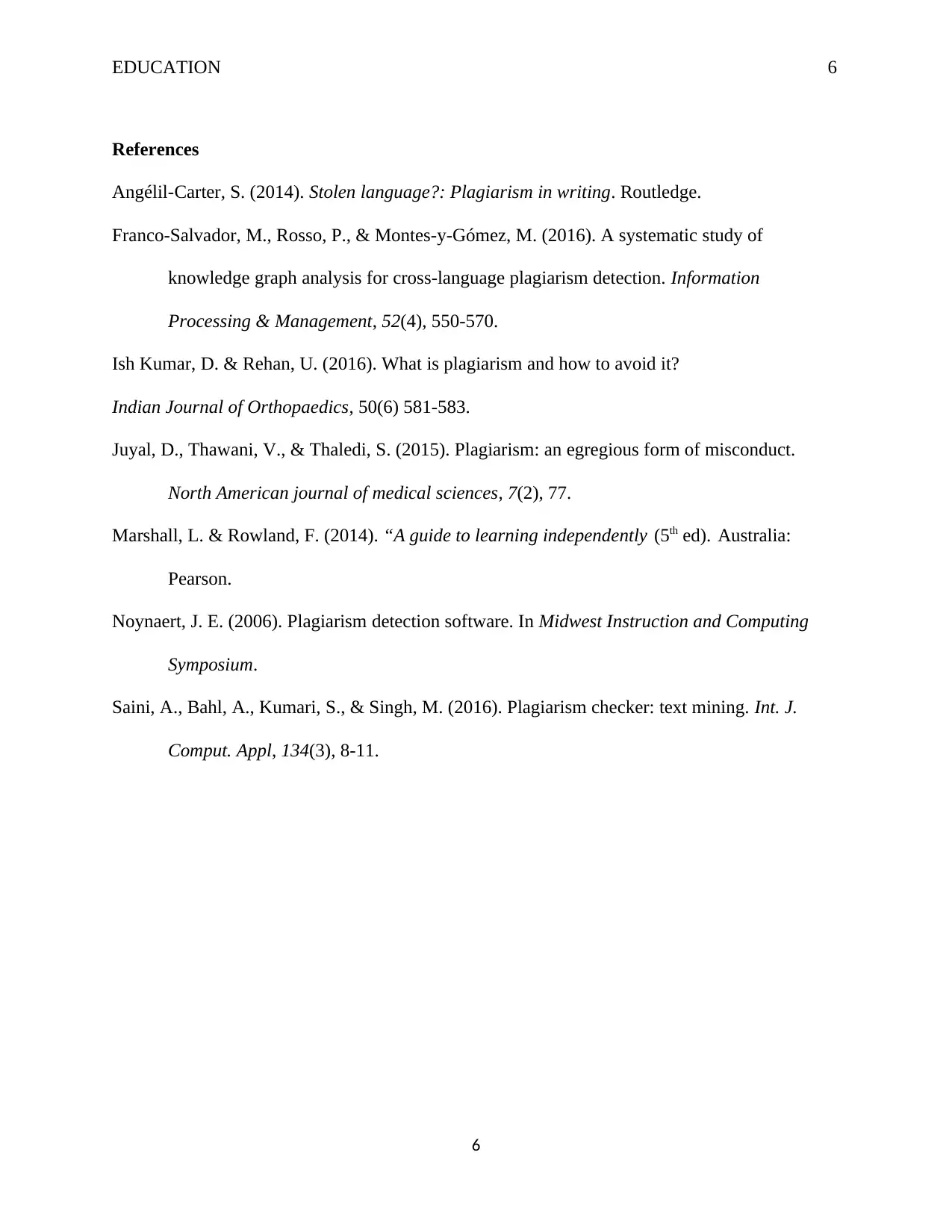
EDUCATION 6
References
Angélil-Carter, S. (2014). Stolen language?: Plagiarism in writing. Routledge.
Franco-Salvador, M., Rosso, P., & Montes-y-Gómez, M. (2016). A systematic study of
knowledge graph analysis for cross-language plagiarism detection. Information
Processing & Management, 52(4), 550-570.
Ish Kumar, D. & Rehan, U. (2016). What is plagiarism and how to avoid it?
Indian Journal of Orthopaedics, 50(6) 581-583.
Juyal, D., Thawani, V., & Thaledi, S. (2015). Plagiarism: an egregious form of misconduct.
North American journal of medical sciences, 7(2), 77.
Marshall, L. & Rowland, F. (2014). “A guide to learning independently (5th ed). Australia:
Pearson.
Noynaert, J. E. (2006). Plagiarism detection software. In Midwest Instruction and Computing
Symposium.
Saini, A., Bahl, A., Kumari, S., & Singh, M. (2016). Plagiarism checker: text mining. Int. J.
Comput. Appl, 134(3), 8-11.
6
References
Angélil-Carter, S. (2014). Stolen language?: Plagiarism in writing. Routledge.
Franco-Salvador, M., Rosso, P., & Montes-y-Gómez, M. (2016). A systematic study of
knowledge graph analysis for cross-language plagiarism detection. Information
Processing & Management, 52(4), 550-570.
Ish Kumar, D. & Rehan, U. (2016). What is plagiarism and how to avoid it?
Indian Journal of Orthopaedics, 50(6) 581-583.
Juyal, D., Thawani, V., & Thaledi, S. (2015). Plagiarism: an egregious form of misconduct.
North American journal of medical sciences, 7(2), 77.
Marshall, L. & Rowland, F. (2014). “A guide to learning independently (5th ed). Australia:
Pearson.
Noynaert, J. E. (2006). Plagiarism detection software. In Midwest Instruction and Computing
Symposium.
Saini, A., Bahl, A., Kumari, S., & Singh, M. (2016). Plagiarism checker: text mining. Int. J.
Comput. Appl, 134(3), 8-11.
6
⊘ This is a preview!⊘
Do you want full access?
Subscribe today to unlock all pages.

Trusted by 1+ million students worldwide
1 out of 6
Related Documents
Your All-in-One AI-Powered Toolkit for Academic Success.
+13062052269
info@desklib.com
Available 24*7 on WhatsApp / Email
![[object Object]](/_next/static/media/star-bottom.7253800d.svg)
Unlock your academic potential
Copyright © 2020–2025 A2Z Services. All Rights Reserved. Developed and managed by ZUCOL.





